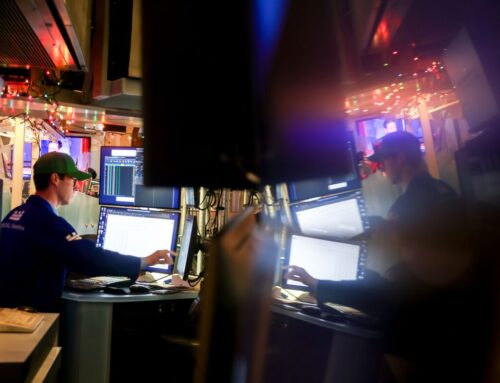Playing on a Loop at JCTC, Short Film ‘Perennial Land’ Confronts an Environment in Peril
April 6, 2025
Koyaanisqatsi, an epic 1982 film, used images of the earth’s grandeur to raise consciousness about the environment in peril. It was the sort of documentary that begged to be shown on a big screen: a compendium of footage of huge flocks of birds in flight, thunderous rivers, forests, and sped-up sunrises and sunsets over mountain ranges. Much of this stuff has become IMAX cliché, but it was nothing of the sort when the movie came out. Its creators were betting that a good long glimpse at the glory of the natural world (coupled with a soundtrack by minimalist composer Philip Glass) might compel viewers to protect it.
It hasn’t worked out that way. Forty years later, human beings still struggle with the moral responsibility that accompanies stewardship of the planet. As another Earth Day approaches, authorities around the world continue to disregard the consequences of widespread habitat destruction — including the corrosive effect our practices have on our own habitat. Part of the reason that artists in Jersey City return to the topic of the biome as often as they do is because somebody has to ring the alarm. There are limits to what can be done with a paintbrush, or a song, or a poem, or a short, but creative people with legitimate concerns will use the tools they’ve got. For local filmmakers Isabelle Duverger and Laia Cabrera, that means video cameras, interactive projections, a lengthy shout-out to embattled Liberty State Park, and a dossier stuffed with facts.
“Perennial Land: The Data Forest,” a twelve minute film installation that will play at the Jersey City Theater Center (165 Newark Ave.) until Thursday, April 10, doesn’t have the scope of Koyaanisqatsi. Yet watching it isn’t a dissimilar experience. Duverger and Cabrera shoot for immersion in the color, scale, and mutability of the natural world, filling the entire south wall of the JCTC performance area with a restless horizontal image of the outdoors at its most elemental. As the video saturates our field of vision, we’re plunged into the forest, hurled across the sky, and stirred up by the undulations of ocean waves. When the picture is this big, viewers are invariably taken for a ride. You’ll feel it in your belly when the scenery shifts.

The filmmakers are also inviting attendees to become part of the project. Programmer and engineer Jianhao Ma has tricked out the video to make it respond to physical movement. Stand in front of a shot of the desert and wave your arms, and you’ll get it to rain. A digital extrapolation of your body may dissolve into stardust as you walk into the projector’s beam. The interactive elements aren’t integrated in the twelve minute film loop designed to make the directors’ points; instead, they’ll be available to attendees after the main movie is finished. Then the original video will play again, followed by the interactive bits, followed by the movie, followed by the bits, until it’s time to turn off the projectors for the night.
All of this fits neatly with the digital-age aesthetic of the directors, and maybe their techno-optimism, too. “Perennial Land” often looks and feels like like a representation of nature as it might be viewed, probed, sorted, and augmented by a mainframe. There are lines and arrays of dots in computer green, and animated probes that suggest a network penetrating the canopy of leaves, tracing the contours of branches, and popping factoids on the great readout of the sky. The video camera feels like a diagnostic tool as well as a storytelling device. Things aren’t merely shown: they’re also being measured.
Sometimes the filmmakers push toward verisimilitude. More often, “Perennial Land” is the forest electrified. Duverger and Cabrera echo the look of high-resolution video games, thick-pixel simulations, and even screen savers. Words and numbers, some of them prescriptive, are superimposed on the forest and the earth, typed out by the invisible hand of Gaia in a presentation-ready font. The design of “Perennial Land” suggests a natural world under the supervision of a benign computer — a smart processor here to provide us with statistics about tree cover and the rate of our consumption.
Aesthetically, this is an impressive achievement. But “Perennial Land” isn’t just here to look cool. It also tries to raise consciousness about a planetary problem. The directors (and other techno-environmentalists with similar aims) may seem to have a simple program for us to follow, but the dance they’re calling for is surprisingly complex. First, they’d like us to accept that the natural world is a beautiful place. Then, they expect that recognition of its beauty will engender protective feelings. Those sentiments must translate into a desire to make behavioral adjustments. The effectiveness of that action is dependent on understanding. It is our knowledge of the natural world — our data — that allows us to know what to do to keep the planet healthy. Thus, it’s in the interest of the species to spread our technology as far and as fast as we can.
This fragile chain of reasoning can break at any point. Audiences may find the wilderness unruly and off-putting rather than winsome. Even if they thrill to dramatic pictures of the environment, they may not agree that beauty is a sufficient cause for preserving something. Viewers may be moved by the plight of the trees, but only in the limited way that they might cry over the fate of a fictional character before shutting the book. They may decide that all of our invasive mapping, weighing, and measuring — science, to put it flatly — isn’t getting us any closer to the thrumming heart of the biosphere.
It’s worth contrasting “Perennial Land” with “At Work,” a blowout exhibition devoted to the Connecticut multimedia artist James Prosek, now on view at the Morris Museum. Prosek also presents the natural world as an awesome thing, but he rejects the idea that cataloguing by humans, digital or otherwise, is a helpful way to approach the ecosystem and the unclassifiable creatures within it. His plants and animals are beautiful, but they’re also abject, not at all like us, and nothing we can identify with. Unlike the “Perennial Land” directors, Prosek shows us the ugly side of the biome, including decay and death. We cannot, “At Work” says to us, base our defense of the environment on human concepts like prettiness, because nature isn’t pretty. It’s wild. Not only will we never master it, we’ll never even comprehend it.
The trouble with Prosek’s approach, wise as it is, is that it requires people to care for what they cannot know. That’s a heavy lift. We are a self-absorbed bunch, and if we can’t see our footprints in the forest — if we don’t believe that our influence and guidance is essential to the well-being of the biosphere — we’re likely to tune out. Prosek is surely correct that our man-made taxonomies distort our understanding of the natural world, and he’s right to remind us that neither flora nor fauna take orders from science. But his humble, skeptical vision leaves conservationists with little to do but step back.
“Perennial Land” is a different sort of project. Its creators ask us to learn all we can about the planet, transmit that knowledge through technology, and apply those lessons widely, with particular emphasis on the digitally underserved communities that have been carrying the heaviest burden from widespread environmental degradation. It’s a plan. Those who believe we’re not getting out of this global mess without one will find its clarity and confidence refreshing.
That makes it a suitable finale for the current chapter in the history of the Jersey City Theater Company. The forest isn’t the only thing that’s changing: the Downtown streetscape is in a constant state of flux, too. “Perennial Land: The Data Forest” is the last thing that’ll ever be shown at the old building on the corner of Newark Avenue and Erie Street. JCTC has always believed that art has a role to play in changing minds and refashioning a planet in trouble, and an optimistic piece like this one — a film where attendees can actually alter the entertainment through the practical activism of using their own bodies and their own initiative — feels like an appropriate landing place. They’ve always wanted you to leave the theater with the faith that there’s something you can do about what you’ve seen. That’s been their ethos. They’ll take it with them wherever they go next.
(“Perennial Land” will be shown on a loop at the Jersey City Theater Company today from 1 p.m. until 6 p.m. and from Monday through Thursday from 4 p.m. until 9 p.m.)
Search
RECENT PRESS RELEASES
Related Post




